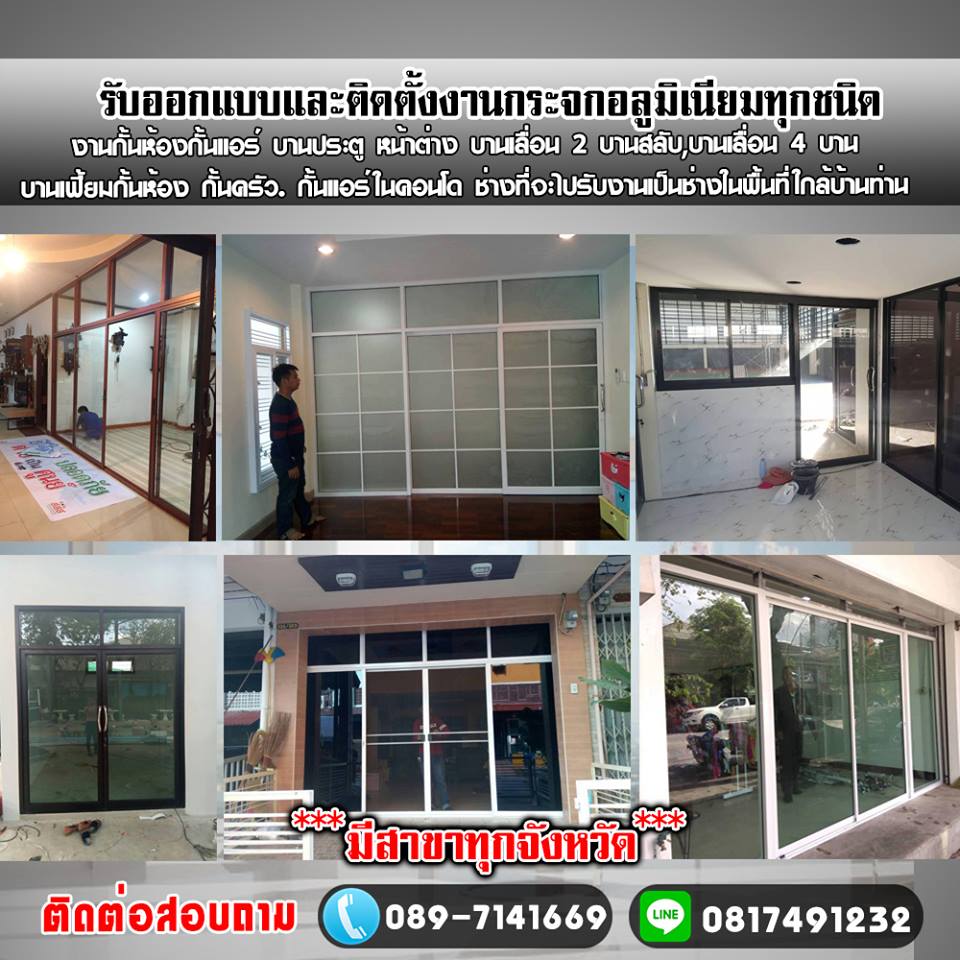คุณสมบัติ และข้อดี - ข้อเสีย กระจกแต่ละประเภท
คุณสมบัติ และข้อดี - ข้อเสีย กระจกแต่ละประเภท
กระจกนิรภัยเทมเปอร์ (Tempered Glass หรือ T/P ) หรือที่เรียกว่ากระจกอบ
Benefit : ข้อดี
- มีความแข็งแรงกว่ากระจกโฟลท 4-5 เท่า ทำให้สามารถรับแรงกระแทก แรงกด และแรงบีบได้ดี
- ทนความร้อนได้สูงถึง 290ºC โดยกระจกไม่แตก
- ทนการเปลี่ยนแปลงของอุณหภูมิอย่างฉับพลันได้ถึง 150ºC
Disadvantage : ข้อเสีย
- กระจกนิรภัยเทมเปอร์ไม่สามารถ ตัด เจีย บาก เจาะ ได้
- เนื่องด้วยกระจกนิรภัยเทมเปอร์ เป็นกระจกที่ผ่านกระบวนการความร้อนสูง
กระจกลามิเนต (Laminated Glass)
กระจกลามิเนต จัดเป็นกระจกนิรภัยชนิดหนึ่ง ที่เวลาแตกแล้วเศษกระจกจะยังคงยึดติดกันโดยไม่ร่วงหล่น
Benefit : ข้อดี
- เมื่อกระจกได้รับความเสียหายจนเกิดการแตก เศษกระจกจะไม่ร่วงหล่นลงมา ซึ่งช่วยลดอันตรายได้มากขึ้น
- ช่วยป้องกันเสียงรบกวนภายนอก และเก็บเสียงได้ดีกว่ากระจกธรรมดา
- ช่วยป้องกันความร้อนได้ดี และกันรังสียูวีได้มากกว่า 90 %
Disadvantage : ข้อเสีย
- ฟิล์ม PVB มีคุณสมบัติดูดความชื้น จึงทำให้ถ้าใช้กระจกนี้บริเวณที่มีความชื้นสูง จะทำให้การยีดเกาะระหว่างกระจกและฟิล์มไม่ดี และอาจเกิดการแยกตัวออกจากกันได้
กระจกลามิเนตฮีทสเตร็งเท่น (Heat-Strengthened Laminate Glass) คืออะไร
กระจกลามิเนตฮีทสเตร็งเท่น คือ กระจกฮีทสเตร็งเท่นที่ผลิตด้วยกระบวนการเดียวกับกระจกนิรภัยเทมเปอร์ แต่จะต่างกันที่กระบวนการทำให้เย็นด้วยการเป่าลม
Benefit : ข้อดี
- มีความแข็งแรงกว่ากระจกโฟลท 2 เท่า ทำให้สามารถร้บแรงกระแทก แรงกด แรงบีบ ได้ดี
- ทนต่อแรงดันของกระแสลมในที่สูงได้ดี โดยเฉพาะผนังอาคารสูง พื้นกระจก หรือ หลังคากระจก
- ทนความร้อนแบบปกติได้สูงถึง 290ºC โดยที่เนื้อกระจกไม่ปริแตก
Disadvantage : ข้อเสีย
- ไม่สามารถ ตัด เจีย เจาะ บาก ได้ ดังนั้นการวัดพื้นที่จำเป็นต้องวัดอย่างระมัดระวัง
- เนื่องจากเป็นกระจกที่ผ่านกระบวนการความร้อนสูงจนเนื้อกระจกนิ่ม กระจกอาจเป็นคลื่น
- ไม่สามารถใช้ทดแทนกระจกกันไฟได้ เพราะกระจกฮีทสเตรงค์เท่นไม่สามารถกันไฟเพื่อความปลอดภัย
กระจกกันเสียง (Acoustic Glass) คืออะไร
Material Type : ประเภทของกระจกกันเสียง
มี 4 ประเภท ดังนี้
กระจกชั้นเดียว (Single Glazing)
2. กระจกลามิเนต (Laminated Glass)
3. กระจกสองชั้น (Double Glazing)
4. กระจกสองชั้น แบบผสมผสาน (Double Glazing Mix & Match)
Features and advantages - disadvantages of each type of glass
Tempered glass (Tempered Glass or T/P), also known as annealed glass.
Benefit : advantages
- 4-5 times stronger than float glass, making it able to withstand impact, pressure and compression well.
- Heat resistant up to 290ºC without breaking glass
- Resistant to sudden temperature changes up to 150ºC
Disadvantages : Disadvantages
- Tempered glass can not cut, chia, notch, drill.
- Due to tempered safety glass It is a glass that has undergone a high heat treatment process.
Laminated Glass
Laminated glass is a type of safety glass. When broken, the glass shards will still stick together without falling off.
Benefit : advantages
- When the glass is damaged until it breaks Broken glass will not fall down. Which reduces the danger more
- Helps prevent outside noise and better soundproof than normal glass
- Helps to prevent heat well and block more than 90% of UV rays
Disadvantages : Disadvantages
- PVB film has hygroscopic properties. Therefore, if using this glass in areas with high humidity Will make the adhesion between the glass and the film is not good. And may be separated from each other
Heat-Strengthened Laminated Glass What is Heat-Strengthened Laminate Glass?
Heat-strengthened laminated glass is heat-strengthened glass produced with the same process as tempered safety glass. But they differ in the cooling process by air blowing.
Benefit : advantages
- It is 2 times stronger than float glass, making it able to withstand impact, pressure, and compression well.
- Withstands the pressure of high air currents well especially high-rise building walls, glass floors or glass roofs
- Can withstand normal heat up to 290ºC without breaking the glass
Disadvantages : Disadvantages
- Can't cut, grind, drill, bevel, so measuring the area needs to be measured carefully.
- Because it is a glass that has undergone a high heat process until the glass is soft. Mirrors can be waves
- Cannot be used as a replacement for fireproof glass Because heat-strength glass can't be fireproof for safety.
What is acoustic glass?
Material Type : soundproof glass type
There are 4 types as follows:
1. Single Glazing
2. Laminated Glass
3. Double Glazing
4. Double Glazing Mix & Match
特点和优点 - 每种玻璃的缺点
钢化玻璃(Tempered Glass 或 T/P),又称退火玻璃。
优点:优点
- 强度是浮法玻璃的 4-5 倍,使其能够很好地承受冲击、压力和压缩。
- 耐热高达 290ºC,不会破坏玻璃
- 耐受高达 150ºC 的突然温度变化
缺点:缺点
- 钢化玻璃不能切割,chia,缺口,钻孔。
- 由于钢化安全玻璃它是一种经过高热处理工艺的玻璃。
夹层玻璃
夹层玻璃是一种安全玻璃。破碎时,玻璃碎片仍会粘在一起而不会脱落。
优点:优点
- 当玻璃被损坏直至破碎 破碎的玻璃不会掉落。哪个更能降低危险
- 有助于防止外界噪音和比普通玻璃更好的隔音效果
- 有助于防止热量和阻挡超过 90% 的紫外线
缺点:缺点
- PVB 薄膜具有吸湿性。因此,如果在湿度高的地区使用这种玻璃,会使玻璃与薄膜之间的附着力不好。并且可能彼此分离
热强化夹层玻璃 什么是热强化夹层玻璃?
热强化夹层玻璃是采用与钢化安全玻璃相同的工艺生产的热强化玻璃。但它们的不同之处在于吹气的冷却过程。
优点:优点
- 强度是浮法玻璃的 2 倍,使其能够很好地承受冲击、压力和压缩。
- 能很好地承受大气流的压力,尤其是高层建筑的墙壁、玻璃地板或玻璃屋顶
- 可承受高达 290ºC 的正常热量而不会破坏玻璃
缺点:缺点
- 不能切割、研磨、钻孔、斜角,因此测量区域需要仔细测量。
- 因为它是经过高温处理直至玻璃变软的玻璃。镜子可以是波浪
- 不能用作防火玻璃的替代品,因为热强度玻璃不能防火,以确保安全。
什么是声学玻璃?
材料类型:隔音玻璃类型
有以下4种类型:
1. 单层玻璃
2.夹胶玻璃
3. 双层玻璃
4. 双层玻璃混搭


